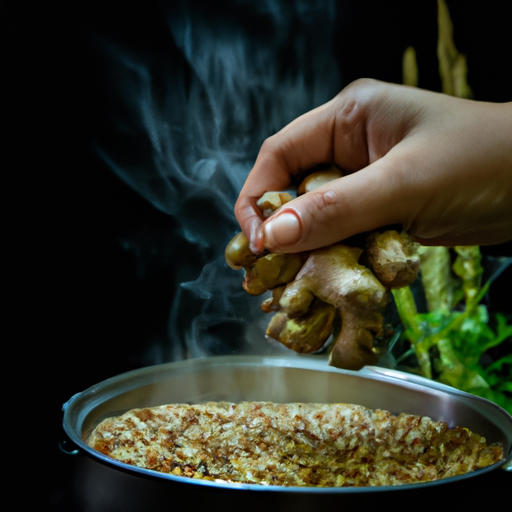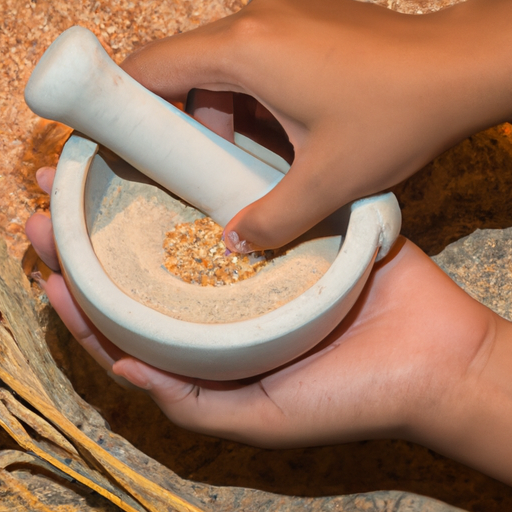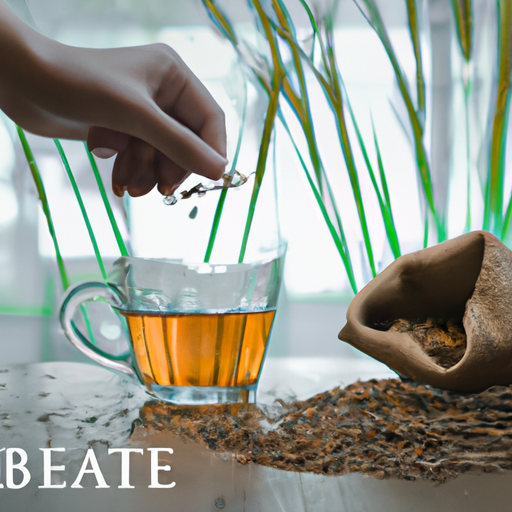The adage ‘an apple a day keeps the doctor away’ is well-known, but have you considered the merits of barley tea? This soothing and warm drink holds a place of significance in various cultures for hundreds of years due to its wide array of health advantages.
If you’re looking to try something new and incorporate more natural remedies into your daily routine, making organic barley tea at home is a great place to start.
In this article, I will guide you through the process of making organic barley tea from scratch. We’ll cover everything from gathering your supplies to serving suggestions and even some tips and tricks along the way.
So grab a mug and let’s get started on this delicious journey towards better health!
Key Takeaways
- Use reputable brands for organic barley, such as Bob’s Red Mill, Arrowhead Mills, and Eden Organic.
- Roast barley grains before adding them to water to enhance their nutty flavor.
- Steep barley-infused water for at least 10 minutes to absorb all nutrients and flavors.
- Enhance flavor with additional ingredients such as honey, lemon juice, cinnamon, ginger, or mint.
Gather Your Supplies
Before you can start making organic barley tea, you’ll need to gather all of the necessary supplies! First and foremost, you’ll need organic barley grains. Make sure to purchase a brand that’s reputable and known for producing high-quality organic barley. Some of the best brands for organic barley include Bob’s Red Mill, Arrowhead Mills, and Eden Organic.
Aside from the main ingredient, you’ll also need a few other items to properly prepare your tea. These include a pot with a lid, water for boiling, and a fine mesh strainer. You may also want to consider adding additional flavorings like honey or lemon juice to enhance the taste of your tea.
Organic barley has numerous health benefits that make it an excellent choice for tea-making. It’s packed with nutrients like fiber, protein, vitamins B1 and B3, magnesium, phosphorus, copper and chromium. Additionally, consuming organic barley can help lower cholesterol levels and regulate blood sugar levels in individuals who are diabetic or pre-diabetic.
Now that we’ve gathered our supplies, let’s move on to preparing the barley grains!
Preparing the Barley Grains
To start, you’ll need to prepare the barley grains by cleaning and soaking them. First, rinse the barley thoroughly under running water to get rid of any dirt or debris. Then, place it in a bowl and fill it up with enough water to cover the grains completely.
Next, let the grain soak for at least 30 minutes or up to an hour. Soaking helps soften the outer layer of the barley kernels and makes them easier to roast later on. You can also experiment with different soaking techniques such as cold soaking or hot soaking depending on your preference.
After you’ve finished soaking your barley grains, it’s time to roast them! Roasting gives your tea a unique flavor and aroma that’s both nutty and slightly sweet. There are different roasting variations you can try out until you find one that suits your taste buds perfectly.
Now that we have our roasted barley grains, let’s move onto brewing this delicious tea!
Brewing the Tea
So, now that I’ve got my organic barley grains ready, it’s time to start brewing my tea.
First things first, I fill up my kettle with water and set it on the stove to boil.
Once the water is boiling, I add in a handful of the prepared barley grains and let them steep for about 10-15 minutes.
During this time, I like to cover the pot with a lid to help keep all of those delicious flavors trapped inside.
Boiling the Water
As I’m preparing to make organic barley tea, the first step is boiling water. Boiling water is an essential part of making any tea, as it helps to extract the flavors and nutrients from the ingredients.
Here are a few things to keep in mind when boiling water for your organic barley tea:
- Use fresh, cold water: Starting with cold water ensures that your tea will taste clean and pure.
- Heat the water to the right temperature: Different teas require different temperatures for optimal brewing. For organic barley tea, you’ll want to heat the water to just below boiling point (around 195°F).
- Keep an eye on the time: Overheating or over-boiling can cause your tea to become bitter or astringent.
Once you’ve boiled your water, it’s time to move on to the next step – adding the barley grains.
Adding the Barley Grains
Once the water has reached the optimal temperature, it’s time to toss in the barley grains. But before that, I prefer to toast them for a bit to bring out their nutty flavor. Toasting barley is easy; all you need to do is heat up a dry skillet on medium-high heat and add the grains. Keep stirring them until they turn golden brown and emit an aroma. Once toasted, let them cool down before adding them into the water.
When it comes to choosing which barley grains to use, there are several varieties available in the market. You can opt for hulled or pearled barley, with each having its own benefits and flavors. Hulled barley still has its outer shell intact and takes longer to cook but is nutritionally richer than pearled barley. Pearled barley, on the other hand, is polished to remove its bran layer and cooks faster than hulled barley but with fewer nutrients. Regardless of what variety you choose, make sure they are organic and free from any additives or preservatives.
Now that we have added our toasted barley grains into our hot water, let’s move on to letting the tea steep for some time.
Letting the Tea Steep
To get the perfect balance of flavor, you’ll want to let the barley-infused water steep for at least 10 minutes. This allows the water to fully absorb all of the nutrients and flavors from the barley grains.
However, did you know that there are benefits to letting your tea steep for even longer than 10 minutes? Here are three reasons why a longer steeping time can enhance your organic barley tea experience:
-
Increased Nutrient Absorption – The longer you allow your tea to steep, the more nutrients will be released into the water. This means that not only will your tea taste better, but it will also be more nutritious.
-
Enhanced Flavor – Similar to how wine becomes richer in flavor over time, letting your tea steep for a longer period of time can intensify its flavor profile. You may notice subtler notes in your barley tea that weren’t present when you first brewed it.
-
Using Different Water Temperatures – Depending on what temperature water you use to brew your tea, different flavors and benefits may be extracted from the barley grains as they soak in hot or cold liquid. Experimenting with different temperatures and times can lead to unique variations on this classic beverage.
With these benefits in mind, it’s easy to see why taking some extra time during this step is worth it! Once your desired steeping time has passed, we can move onto straining our delicious organic barley tea.
Straining the Tea
Now that the tea has steeped, it’s time to strain out the barley and enjoy your refreshing homemade brew.
There are different straining techniques you can use depending on what tools you have available in your kitchen. One of the easiest ways is to use a fine mesh strainer or sieve to remove the barley from the liquid. Simply place the strainer over a heat-resistant container and pour the tea through it, making sure to catch any stray grains.
Another method is to use cheesecloth as a filter. To do this, cut a piece of cheesecloth large enough to cover the top of your container with some excess cloth hanging off the edges. Secure it in place with an elastic band or string and slowly pour the tea into the container through the cheesecloth. The cloth will catch any solids while allowing liquids to pass through.
Once all of your barley has been removed from the liquid, you can serve your organic barley tea hot or cold according to your preference.
If you want something refreshing during warm weather, chill it in your fridge for at least an hour before serving with ice cubes and fresh mint leaves for extra flavor. Alternatively, if you prefer something hot, simply reheat it on low heat until warm and then serve immediately.
Serving Suggestions
If you’re feeling adventurous, jazz up your homemade organic barley tea with a splash of lemon juice or a pinch of cinnamon for an extra kick. These simple additions can give your tea a burst of flavor and aroma that will take it to the next level. Lemon juice provides a refreshing citrusy tang that complements the nutty taste of barley, while cinnamon adds warmth and depth to the brew.
When it comes to serving organic barley tea, there are a few things to keep in mind. First, consider which foods or snacks would pair well with this earthy drink. Barley tea goes particularly well with savory dishes like grilled meats or roasted vegetables, as its slightly bitter taste helps cleanse the palate between bites. Additionally, try serving your tea at different temperatures – chilled on hot summer days or warm on chilly nights – to see which variation suits your taste buds best.
Incorporating these tips into your organic barley tea-making routine can help elevate your drinking experience and allow you to fully appreciate all the health benefits this beverage has to offer.
Speaking of health benefits, did you know that drinking organic barley tea regularly can help improve digestion and boost immunity? Let’s explore more about how this ancient brew can benefit our bodies in the next section.
Health Benefits of Organic Barley Tea
Discover the incredible health benefits you can reap by incorporating organic barley tea into your daily routine. This ancient brew is packed with nutritional benefits that can boost your overall health and wellness.
One of the most significant advantages of drinking barley tea is its ability to regulate blood sugar levels, making it an excellent choice for individuals with diabetes or those at risk.
Organic barley tea is also rich in antioxidants, which help protect your cells from damage caused by free radicals. These antioxidants are essential for reducing inflammation throughout the body, improving heart health, and preventing chronic diseases such as cancer and Alzheimer’s disease.
However, it’s important to note that like any other food or beverage, overconsumption of barley tea can have potential side effects such as bloating and gas due to its high fiber content.
If you’re looking for a simple way to incorporate this nutritious drink into your daily routine, consider brewing a pot of organic barley tea each morning and enjoying it hot or iced throughout the day. And if you happen to have leftover tea at the end of the day, don’t worry! Simply store it in an airtight container in the refrigerator for up to three days and enjoy it cold or reheated whenever you need a refreshing pick-me-up.
Storing Leftover Tea
So you just brewed a pot of this magical elixir, and now you’re wondering how to store the leftover liquid gold without it turning into a science experiment? Well, fear not my friend, because I’ve got some tips for maximizing freshness and preventing spoilage.
The first thing to keep in mind is that barley tea should be stored in an airtight container at room temperature. This will help prevent moisture from seeping in and spoiling the tea.
Another important factor to consider is the shelf life of your barley tea. While freshly brewed tea can last up to 24 hours at room temperature, it’s best to consume within six hours for optimal taste and health benefits. If you want to extend the lifespan of your barley tea beyond 24 hours, consider storing it in the fridge or freezer. Just be sure to transfer it into an airtight container first.
To ensure maximum freshness when reheating refrigerated or frozen barley tea, simply heat it up on low heat until warm before serving. Avoid boiling or overheating as this can cause the flavor and nutritional value of your tea to deteriorate.
With these tips in mind, you’ll be able to enjoy delicious, nutritious barley tea long after brewing time has ended! Now onto some more tips and tricks for brewing organic barley tea…
Tips and Tricks
When it comes to making barley tea, I’ve found that experimenting with roasting the barley can really change the flavor profile. Adding other herbs or spices like cinnamon or ginger can also add a nice kick to the tea. In my experience, trying out different combinations and levels of ingredients has led to some truly unique and delicious cups of barley tea.
Experimenting with Roasting
To get the perfect flavor for your organic barley tea, you should try experimenting with roasting the grains yourself. There are many different roasting techniques that can be used to achieve different flavor profiles in your tea.
One method involves placing the barley grains in a dry skillet over medium heat and stirring constantly until they turn golden brown. Another approach is to roast them on a baking sheet in the oven at 350°F for about 15-20 minutes.
The key to successful roasting is to pay close attention to the grains and remove them from heat as soon as they reach your desired level of toastiness. This will help prevent burning or over-roasting, which can result in bitter flavors in your tea.
Once you’ve roasted your barley, you can use it immediately or store it for later use. Roasted barley can add depth and complexity to all sorts of teas, so don’t be afraid to experiment with different blends and brewing methods. Adding other herbs or spices can also enhance the flavor even more!
Adding Other Herbs or Spices
Spice up your roasted grains by experimenting with other flavorful herbs and spices! Adding other herbs or spices to organic barley tea can enhance its taste and aroma, giving you a unique and refreshing beverage.
Here are some suggestions on how to incorporate other herbs or spices in your organic barley tea:
-
Cinnamon: Add a dash of cinnamon powder to your organic barley tea for a warm and comforting flavor. This spice is known for its anti-inflammatory properties and can help regulate blood sugar levels.
-
Ginger: Grate some fresh ginger root into your organic barley tea for a zesty kick. Ginger has been used for centuries as a natural remedy for nausea, indigestion, and sore throat.
-
Mint: Crush some fresh mint leaves into your organic barley tea for a cool and refreshing taste. Mint is known for its soothing effect on the digestive system and can help alleviate bloating and gas.
-
Lemon: Squeeze some lemon juice into your organic barley tea for a citrusy twist. Lemon is rich in vitamin C, which helps boost immunity, aids digestion, and promotes healthy skin.
You can also experiment with combining organic barley tea with other beverages like green tea, honey water, or fruit juices. The possibilities are endless! Don’t be afraid to mix and match different flavors until you find the perfect combination that suits your taste buds.
Enjoy!
Frequently Asked Questions
Can I make barley tea with pearled barley?
Funny you should ask, because just the other day I was wondering if I could make barley tea with pearled barley.
After some research and experimentation, I found that yes, you can! The cooking method is pretty straightforward – just boil water and add the pearled barley to it. Let it simmer for about 20-30 minutes until the water turns a golden brown color.
Then strain out the barley and let the tea cool down before enjoying. As for health benefits, barley tea is known to have antioxidant properties and can aid in digestion. It’s also caffeine-free so it makes for a great alternative to traditional teas or coffee.
Overall, making your own homemade pearl barley tea is an easy way to incorporate some healthy habits into your routine.
How long does the tea need to steep for optimal flavor?
When it comes to steeping organic barley tea, the optimal duration will depend on several factors. Generally, I find that a steep time of 5-7 minutes works well for achieving a balanced flavor profile and intensity.
However, you may need to adjust this based on your personal taste preferences or the specific brewing techniques you’re using. For example, if you prefer a stronger flavor, try steeping for closer to 10 minutes.
Alternatively, if you want a milder taste or are concerned about bitterness, opt for a shorter steep time of around 3-4 minutes. Ultimately, experimentation is key when it comes to finding your perfect cup of barley tea!
Can I add sweeteners like honey or sugar to the tea?
Yes, you can add organic sweeteners like honey or natural substitutes such as stevia to your barley tea. However, it’s important to note that the natural sweetness of barley tea is already quite pleasant and adding too much sugar or honey may overpower its delicate flavor.
Using organic sweeteners can provide health benefits and nutritional value to your beverage. For example, honey contains antioxidants and has antibacterial properties while stevia is a zero-calorie alternative that doesn’t affect blood sugar levels.
Ultimately, the choice of whether or not to sweeten your organic barley tea comes down to personal preference and dietary needs.
Can I reuse the barley grains to make a second batch of tea?
I’ve found that reusing barley grains to make a second batch of tea is not only possible, but it’s also a great way to maximize the nutritional benefits.
Barley contains fiber, vitamins, and minerals that are released into the water when steeped for an extended period. By reusing these grains, you can extract even more of those nutrients.
In fact, some cultures have been known to reuse their barley grains up to three times! Just be sure to store them properly in between uses and adjust your brewing time accordingly. It may take a bit longer for subsequent batches, but it’s worth it for the added health benefits and reduced waste.
Are there any potential side effects or risks associated with drinking barley tea?
When it comes to drinking barley tea, there are a few potential health benefits to consider. Some studies have suggested that barley tea may help reduce inflammation and improve digestion. It’s also low in calories and caffeine-free, which makes it a great alternative to other beverages like soda or coffee.
However, as with any food or drink, it’s important to consume barley tea in moderation and be aware of any potential side effects. While there aren’t many known risks associated with drinking barley tea, some people may experience allergic reactions or digestive discomfort if they consume too much.
As for recommended daily intake, there isn’t a specific guideline but it’s generally advisable to limit your consumption to a few cups per day.
Conclusion
Overall, making organic barley tea is an easy and rewarding process. By following the steps outlined in this article, you can create a delicious and nutritious beverage that can be enjoyed hot or cold.
Remember to source high-quality organic barley grains and experiment with different brewing methods to find your perfect cup of tea.
As the old adage goes, "An apple a day keeps the doctor away,"but perhaps we should update it to say, "A cup of organic barley tea a day keeps the health problems at bay."With its numerous health benefits, including improved digestion and lower cholesterol levels, adding barley tea to your daily routine is a smart choice for your overall wellbeing.
So why not give it a try? Gather your supplies, prepare those grains, brew up some delicious tea, and enjoy all the benefits that come with drinking this ancient grain. Cheers!










